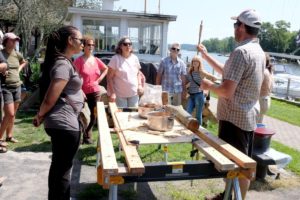Building an Alternative Supply Chain for Shiitake Mushroom Growers
The Logs to NYC project connects city-based mushroom growers with rural landowners and surplus lumber hoping to blaze a trail to lower-carbon living.

The schooner Apollonia.
Doug Bierend
On a recent sunny Saturday afternoon, power tools whirred and wood shavings flew outside the Hudson River Maritime Museum in Kingston, New York. In the shadow of Mathilda, a hefty 19th-century tugboat propped up on stilts alongside Rondout Creek, visitors busily bored holes into freshly cut red oak logs laid out upon sawhorses. Participants in this hands-on shiitake mushroom cultivation workshop each took home one log from a stack of about 300 that altogether weighed some 12,000 pounds. Later that afternoon, the group passed the remaining logs, bucket brigade-style, into the hold of a graceful sailing schooner, the Apollonia, docked just steps away, beginning a week-long journey some 100 miles down the Hudson River to Brooklyn.
This unlikely combination of elements—mushrooms, a huge pile of logs, a sailboat bound for the big city—was the culmination of a multifaceted experiment that asked: Is it possible to deliver resources from a region where they’re plentiful to one where they are scarce, while prioritizing sustainability and supporting a local economy?
The Global Business of Domestic Mushrooms

Students learning how to inoculate shiitake logs.
Doug Bierend
Many mushroom eaters may not realize the extent to which the industry—especially shiitakes and the logs used to grow them—has become dominated by overseas imports. Shiitake have been cultivated for thousands of years, particularly in China, Korea, and Japan. The traditional method starts with a hardwood log like white oak, beech, or sugar maple, usually no more than 10 inches in diameter, and no more than a few weeks old, always with the bark still intact. After drilling holes around the log in a diamond pattern, a kind of mechanical turkey baster is used to fill them with “spawn,” the starting mix of sawdust and fuzzy fungal mycelium that spreads throughout the wood. Some growers use wooden furniture dowels to start their logs.
Inoculation spots are brushed over with melted wax to keep competing microbes out and moisture in. The logs are then stacked in a shady outdoor spot for six to 18 months. Once shot through with mycelium, an overnight soak in cold water and a strike with a rock or sledgehammer (seriously) helps induce the fungus inside the log to start producing pound after pound of mushrooms. They will often produce “flushes” for several years in a row.
In 1972, the U.S. Department of Agriculture (USDA) lifted a ban on importing live shiitake cultures, which kicked off the U.S. industry; between 1986 and 2008, annual domestic shiitake production jumped from fewer than 1 million pounds to more than 10 million, and the price dropped from $5.40 to $2.81 per pound. This sea change took place in large part as a result of a broad shift to synthetic logs, or blocks, made with compressed sawdust, sealed and shipped in polypropylene. These pre-inoculated blocks are much cheaper, can be cultivated indoors year-round, and work much faster because the shredded substrate is easier for the fungus to consume (though many note a distinct difference in the flavor of the mushrooms they produce).
American mushroom companies typically manufactured their own spawn and sawdust blocks, until around five years ago, when the market quickly became flooded with cheaper imported blocks, mostly from China. These blocks sell for a fraction of the price of anything made domestically, despite the thousands of extra miles involved in transportation. Since they also save the buyer the need to produce spawn, source sawdust, and go through the inoculation process, the choice became clear.
“Block producers review their options and they say, ‘I don’t have the huge overhead, I just need a fruiting room and a good sales attitude for getting rid of fresh mushrooms,’” said Eric Lomen of North Spore Mushrooms in Maine, who along with companies like Top Hat Mushrooms in Oregon are among the very few that have continued producing their own blocks. Otherwise, imports have effectively replaced domestic production. The kicker: since mushrooms sprout from the imported blocks shortly after arriving, they can be labeled “product of the USA.”
Unlike the imported logs, the ones along the Rondout came from just a few miles north. Instead of a flatbed truck, they sailed to the city by the power of wind, then by bicycle for the final delivery. By piecing each element of a supply chain together from scratch, as well as connecting a number of communities aligned by values of non-extractive practices and local exchange, the Logs to NYC Project seeks to meet a need while demonstrating a more sustainable approach to the distribution of resources.
“The abundance of material outside of the city is not showing up downstream,” said Steve Gabriel, extension specialist at the Cornell Small Farms Program, and mastermind behind the Logs to NYC Project, who worked with the Mushroom Shed and other local organizations.

Loading shiitake logs onto the Apollonia.
Doug Bierend
“I was teaching classes, and talking to people in the city who would say, ‘Boy, I’d love to get my hands on some logs.’ It seems so impossible to them, but where I live upstate, I’m tripping over wood, it’s kind of a waste product here in more rural areas. So it struck me that there’s an opportunity to connect those two things.”
Following stops in a handful of other towns along the Hudson River, the Apollonia‘s run ended at Red Hook Community Farms (RHCF). There, a volunteer team of Community Mushroom Educators (CMEs), volunteers trained as part of Cornell’s extension program, inoculated the remaining logs and took them to local community gardens and farms around the city. All told, the full shipment of logs is expected to produce about 1,000 pounds of mushrooms, which will go into CSA boxes and pantry donations, and get sold to restaurants and farm stand customers. For the city’s community gardens and farms, however, it’s not just about production.
“It can also be looked at as a way that we’re expanding our curriculum and educational opportunities,” said Ciara Sidell, urban farm manager at the Randall Island Park Alliance, which took 15 of the logs.
“[Shiitake logs have] been a hotly requested thing by a lot of our community members, and it really fits in with farm production and the labor needs of farming,” said Brendan Parker, farm manager at RHCF, which is keeping its own share of the logs on outdoor stands. “We’re connecting these pieces of upstate forest to New York City.”
Reevaluating Value
Despite the global economics that make imported sawdust blocks such an inexpensive and easy choice, the traditional log method remains popular with small-scale growers. Talk to enough people who live in the woods, and you’ll meet someone who keeps a pile of shiitake logs under a shade cloth. In a big city, one might expect the indoor-friendly sawdust block method to be the first choice, but Gabriel and the Cornell team said that many urban growers have more spare outdoor space to work with. This makes sense, given how expensive indoor square footage can be in NYC. And whether it’s a back yard, a community garden or an urban farm, setting up a stack of logs to sit for a year is often much more feasible than converting an entire room to maintain ideal growing conditions.
Outdoor cultivation strongly favors the traditional method; sawdust blocks offer quick turnaround, to be sure, but they require a controlled indoor environment, while the traditional method requires little more than idle, shady outdoor space. Given the strong interest in urban mushroom cultivation, it seems there should be an easy way of connecting the ample supply of logs upstate with the city’s demand. But, as of now, there isn’t really an economic model that can make it work.
It starts with the logs themselves. Raw wood of this diameter is not economically viable—too small for construction or furniture or other common uses for timber—except as firewood or mushroom logs. Since mushroom logs are typically only sold in small quantities, loggers aren’t likely to collect them. And despite their smaller size, collecting them is a big hassle. Tom Lindtveit, a retired engineer turned freelance logger, gathered the logs used in the Logs to NYC Project over a series of trips to private land upstate. Heavy equipment was a no-go, since it risked damaging the bark and rendering the logs unusable for shiitake, and transportation had to be managed gently, by hand.
“Cutting mushroom logs is some of the heaviest work that you’ll ever want to do,” Lindtveit explained in his gruff New York accent. “It’s backbreaking work, and I sweated more gallons than I’d like to admit. But I’d say 90 percent of them would have gone into the burn pile, so this was a sustainable way to make use of those trees.”
This experiment also relied on a bulk purchase, so that the logger could sell enough to make it worth harvesting in the first place. City dwellers who just wanted a few logs could, as a group, make a larger order to secure the involvement of someone like Lindtveit, one of very few people in the area currently available for this sort of thing. Despite all the hard work and narrow margins involved, Lindtveit says he managed to turn a small profit. By raising the price per log from $4 to $5 in the future, he hopes that shiitake logs can become a sustainable part of his and, perhaps, other loggers’ work.
“I was very surprised to see that, although I didn’t make a ton of money, I didn’t lose money either,” said Lindtveit.
Each log produces about four pounds of mushrooms. With shiitake selling for between $12 and $20 a pound, at five bucks a log, the economics seem like they could work. A big part of the reason for kickstarting this miniature supply chain—from forest to boat to city—was in fact to determine whether the arrangement could be sustained.
“It’s great for R&D,” said Yolanda Gonzalez, urban agriculture specialist with the Cornell Cooperative Extension. Not only did the bulk purchase open a channel for the logs, but their arrival created the opportunity to provide all the means necessary to inoculate them, a kind of community toolshed approach. “Now that we know all these logs have come in, we can uniformly see how they do, and track their progress throughout the city. It also creates access to space and equipment to inoculate,” said Gonzalez, “Not everyone will have access to drills, angle grinders, drill bits, sawhorses, and palettes.”
Then, of course, there’s the boat. The Apollonia is part of what has been dubbed the sail freight movement, which seeks to reclaim the tradition of waterborne trade that once sustained the world economy without the need for fossil fuels. The Hudson River is an ideal venue, with its own rich tradition of maritime trade, the infrastructure for which is still present, albeit largely neglected.
Originally, the Logs to NYC project planned to rent a truck, but when the word went out that thousands of pounds of mushroom logs needed to get to the city, the Apollonia took notice. Though the boat’s crew couldn’t match the delivery timeline of a diesel truck, they offered an approach that was consistent with the project’s spirit of doing things right, rather than fast.
[In the past], when a schooner came to town, that’s how you got the news, that’s how you got the weather, that’s how you got a cool trinket from another town, that’s how you sent a message to your brother—that stuff is what it should be all about,” said Sam Merritt, captain of the Apollonia, which also hauled maple syrup and coffee beans as part of this run, along with a personal parcel as part of its “sail mail” program. “Efficiency comes at a cost sometimes, and there are moments when I would much, much, much rather have 10 people involved handling stuff, one person to the next, so that there’s a story, there’s community, and there’s that moment.”
While not a lot of money traded hands through this project, resources moved from a place where they were abundant to a place where they are scarce, engaging various communities along the way. Gabriel says that despite the promising numbers, this won’t likely lead to any kind of mushroom gold rush. But maybe its success suggests that, for chains of supply to meet everyone’s material needs, they should be motivated by a broader and less extractive concept of value.
Whatever the price per log or pounds of mushrooms produced, this experiment has connected people along a new type of supply chain that is, in some ways, quite old and familiar. And it’s a chain that can be reactivated next year, or the year after that, to ship more logs, or some other resource entirely.
“I think the connections that are going to come out of this are massive,” said Brendan Parker of RHCF. “What other resources are out there, that are [treated as] waste and are readily available, and how can we connect those dots?”

